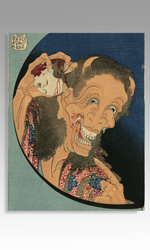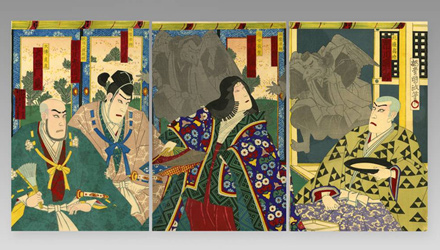In the Dead of Night – Japanese Ghost and Demon Prints
PRIMITIVE - Saturday, October 31, 2015By Misaki Imagawa
 |
|
Edo, Japan. The year was 1749. It was the 15th night of the 7th month, the start of the annual Bon Festival, a celebration honoring the dead. On the edge of town, where the merriments of the festival were subdued, a group of samurai gathered at an old mansion. In the main hall they waited for the darkest hours of the night and lit one hundred candles in a circle. Then, one by one they began to tell tales of ghostly apparitions and demonic encounters they had heard on their travels – scorned lovers returning from the dead for vengeance; flesh-eating ghosts preying on infants; travelers lured to graveyards and discovered dead in the embrace of skeletons; entire villages haunted by the moans and wails of spirits passing on their way to hell. With each story, the narrator blew out a candle, one after another, until there was only one left flickering in the oppressive darkness.
 |
|
The group of samurai could barely see each other now and the creaks of the floorboards could be heard groaning under their weight in the stillness of the air. Then a voice quietly began to speak, piercing the darkness; and the room grew still. "Long ago there lived a beautiful maid servant named Okiku who worked for an unscrupulous lord. He made many advances toward her, but she continually turned him down. One day, he slipped into the storage room where they kept ten highly valuable porcelain plates and hid one in his room. When it was discovered there were only nine plates, Okiku rushed to the storage room, for it had been her responsibility to safeguard the treasures. 'One, two, three, four, five, six, seven, eight, nine...' she counted; and panicked when she couldn't find the tenth. She counted again and again, searched the room high and low, but couldn't find the missing plate.
 |
|
"In despair, Okiku told the lord of the situation. Furious, he threatened to torture and kill her for her incompetence and neglect. 'Unless,' he said, 'you agree to become my mistress.' Okiku bowed low in fear, but shook her head no. In a fit of rage, the lord struck her down and strangled her to death. That night, he threw her body down an empty well and boarded it up. Several months passed. He had forgotten Okiku until one moonless night, as he was strolling through the garden he heard a voice. 'One, two, three, four,' it counted. The lord looked around, holding a lantern high, but saw nothing. 'Five, six, seven, eight.' Startled, he hurried back toward the house, unaware that he was passing close by the well. 'Nine…' An ear-splitting screech rang out – hair-raising and chilling to the bone. The lord screamed and cowered on the ground. Out of the well, a ghostly hand reached through the wooden boards and Okiku's face appeared, no longer pretty but haggard and rotten. Her thin voice floated through the night again, her sunken eyes fixed on the lord: 'One, two, three, four, five, six, seven, eight, nine…' After the last number was recited, the one remaining candle went out. The gathered samurai nervously held their breaths in the dark.
A few coughs broke the silence, until finally one of the samurai said, "That was a good tale. Who told it?" But no reply was forthcoming… because none of them had.
 |
|
Japan is a land immersed in tales of spirits, ghosts, demons and hundreds of other supernatural creatures both benign and malevolent. Stemming from folk religions, Buddhism, stories from neighboring countries, as well as personal experiences of unexplainable mystery, these mythical creatures have been a part of the culture for centuries. They became particularly popular during the Edo Period (1603 - 1868) when a pastime called Hyakumonogatari Kaidankai spread through the aristocratic samurai class. Meaning a 'gathering of a hundred ghost narratives;' tales were told at night by the light of candles. Just listening was considered a true test of courage as the flames were extinguished one by one as if to gradually invoke the dead. This "game" soon spread to all classes and before long, collections of ghost stories were printed in books rousing the interest of playwrights and woodblock artists alike.
Ghosts (yurei) and demons (yokai) quickly became a new genre of woodblock prints. It was traditionally believed in Japan that if a person died a violent death or held strong feelings of anger, revenge, or jealousy, their souls would be turned into a malicious type of yurei called Onryo. Though in life they may have been beautiful or handsome, their apparitions were generally depicted as pale, lifeless and disfigured by negative emotions – certainly not something you would want to see looming in the dark at night. Nor would you want to run into Funa-yurei, spirits of those who perished at sea. They were said to approach unsuspecting boats and fill them with ladles of water to drag the living into the dark depths of the sea with them.
 |
 |
||
Yokai, on the other hand, were more than just ghosts. They were demons causing grim misfortune and curses. Some like Ame Onna, known as the 'rain hag,' appeared silently, drenched by bitter rains she brought wherever she went. Japanese folk legends say she was once a mother who lost her young child and so steals infants from their cribs to get back what was taken from her. Other yokai are more mythological creatures like the Oni and Tengu. The Oni is a fearsome ogre that can feast on flesh among their many other unattractive traits. In the Kabuki play "Momijigari," an Oni transforms into a princess and tries to deceive a samurai so he can feast on his flesh. Luckily the protagonist, Taira no Koremochi, realizes the trick in time and cuts the beautiful kimono away revealing the Oni's ugly figure. The Tengu is another popular yokai with a prominent beak or long nose, wings and a human body dressed in priestly clothes. However, Tengu are harbingers of ill omen and war. One famous print depicts them mocking and tormenting Hojo Takatoki, a weak-minded and barely sane 14th century warlord whose actions brought about the Nanboku-cho civil war. Were the Tengu to blame for his madness?
 |
|
Japan's love for horror has continued unabated from the Edo period to the present day. It is still widely believed that yurei and yokai are lurking everywhere, waiting for the right moment to close their clammy fingers on their prey. But are they really? If you dare to find out, gather around a candle-lit circle this Halloween and begin the Hyakumonogatari Kaidankai. When the last candle is blown out…your answer might be found right beside you in the darkness.
 |